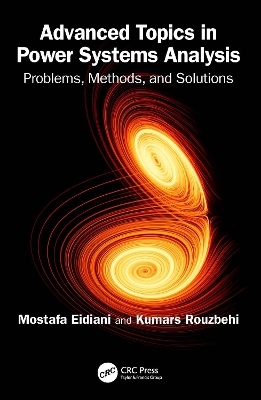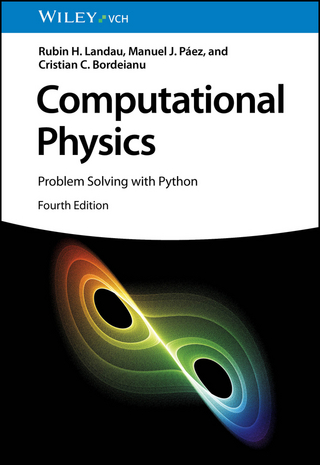
Advanced Topics in Power Systems Analysis
CRC Press (Verlag)
978-1-032-82878-7 (ISBN)
- Noch nicht erschienen (ca. September 2024)
- Versandkostenfrei innerhalb Deutschlands
- Auch auf Rechnung
- Verfügbarkeit in der Filiale vor Ort prüfen
- Artikel merken
This book serves as a continuation of our previous book, "Fundamentals of Power System Analysis 1, Problems and Solutions", specifically delving into advanced topics in power system analysis.
The structure of the "Advanced Topics in Power Systems Analysis" is as follows:
"Economic Load Dispatch", "symmetrical and unsymmetrical short circuits", "Transient Stability Analysis", "Power system linear controls" and "Key Concepts in Power System Analysis, Operation, and Control".
The structure of the "Fundamentals of Power System Analysis 1" is as follows:
"Introduction to the Power System", "Transmission Line Parameters", "Line Model and Performance", "Power Flow Analysis"
In brief, advantages associated with delving into both books are:
· A variety of tests to prepare for employment exams.
· Electrical engineers practicing power system analysis can find almost everything they need.
· This book contains both difficult and easy problems and solutions.
· Readers have the capability to solve problems presented in this book solely using a calculator, without dependence on computer-based softwares.
· This book provides power systems concepts through studying two-choice questions.
In the end, we had a great time in writing this book, and we truly hope you enjoy reading it as much as we enjoyed creating it!
Mostafa Eidiani (StM'98, SM'16) Was born in Mashhad, Iran. He earned a B.S. (with distinction) and M.Eng. degree in electrical engineering from Ferdowsi University of Mashhad, Iran in 1995 and 1997 respectively, as well as his Ph.D. degree from the Science and Research Branch of Islamic Azad University, Tehran, Iran in 2004. In 2016, he was elected a senior member of IEEE, and in 2017, he was elected director of the Iranian Association of Electrical and Electronics Engineers (Khorasan Branch). He was promoted from Assistant Professor to Associate Professor in 2016. His research interests include renewable energy integration, power system control, transient and voltage stability, power system simulation, and DIgSILENT PowerFactory. He has authored or co-authored 8 technical books, 9 chapter books, 40 journal papers, and 110 technical conference proceedings. In addition, he has conducted more than thirty research projects with Iranian power companies. Dr. Eidiani is an Associate Editor for the IET Journal of Engineering (JOE), and Journal of Electrical Engineering & Technology (JEET), and an Editorial Board for the International Journal of Applied Power Engineering (IJAPE), and 9 other journals. He has been a Board Member of Khorasan Electric Generation Company. Dr. Eidiani is the Editor-in-Chief of the International Journal of Energy Security and Sustainable Energy. He is the author of "Fundamentals of Power Systems Analysis I: Problems and Solutions" published by Taylor & Francis Group. Kumars Rouzbehi (Senior Member, IEEE) Received his Ph.D. degree in Electric Energy Systems from the Technical University of Catalonia (UPC), Barcelona, Spain, in 2016. Prior to this, he was an academic staff at the Islamic Azad University (IAU), Iran, from 2002 to 2011. In parallel with teaching and research at the IAU, he was the CEO of Khorasan Electric and Electronics Research Company, from 2004 to 2010. From 2017 to 2018, he was an Associate Professor at the Loyola Andalucía University, Seville, Spain. In 2019, he joined the Department of System Engineering and Automatic Control, University of Seville, Spain. He is the patent holder for AC grid synchronization of voltage source power converters and has contributed to over 100 technical publications, including books, book chapters, journal papers, and technical conference proceedings. Professor Rouzbehi has been a TPC Member of the International Conference on Electronics, Control, and Power Engineering (IEEE.ECCP), since 2014, a Scientific Board Member of the (IEA) International Conference on Engineering and Management, since 2015, and a TPC Member of COMPEL 2020. He is an Associate Editor of the IEEE Systems Journal, IET Generation, Transmission and Distribution, IET Renewable Power Generation, High Voltage (IET), and IET Systems Integration. He received the Second Best Paper Award 2015 from the IEEE Power Electronics Society, IEEE Journal of Emerging and Selected Topics in Power Electronics.
Preface
Foreword
Authors biographies
Chapter One: Economic Load Dispatch
Part One: Lesson Summary
1.1. Introduction
1.2. Minimization
1.3. Equality-constrained optimization with the Lagrange method
1.4. Inequality-constrained optimization with the Kuhn-Tucker method
1.5. Economic load dispatch without transmission losses and power generation limits
1.6. Economic load dispatch without transmission losses and with power generation limits
1.7. Economic load dispatch with transmission losses and power generation limits
1.8. Vector/Matrix relation to solving economic load dispatch
1.9. Determining cost function parameters for power plant
Part Two: Answer Question
1.10. Two-choice questions (Yes/ No)
1.11. Key answers to two-choice questions
1.12. Descriptive questions of economic load dispatch
1.13. Descriptive answers to economic load dispatch
Chapter Two: Three-Phase Symmetrical Short Circuit
Part One: Lesson Summary
2.1. Introduction
2.2. Direct solution method
2.3. Thevenin method
2.4. Short circuit capacity (SCC)
2.5. Matrix relations of short circuit calculations
2.6. Impedance matrix calculation
2.6.1. Reversal method
2.6.1. Direct method
2.7. Two simple algorithms to calculate ZBUS
Part Two: Answer Question
2.8. Two-choice questions (Yes/ No)
2.9. Key answers to two-choice questions
2.10. Descriptive questions of the three-phase symmetrical short circuit
2.11. Descriptive answers to the three-phase symmetrical short circuit
Chapter Three:Three-Phase Unsymmetrical Short Circuit
Part One: Lesson Summary
3.1. Introduction
3.2. Symmetrical components
3.3. Sequence Impedances (+, - , 0)
3.3.1. Star connected load
3.3.2. Symmetric transmission line
3.3.3. Symmetric three-phase transformer
3.3.4. Loaded generator
3.4. Short circuit equivalent circuit
3.4.1. Single phase to ground
3.4.2. Phase-to-phase, 2-phase
3.4.3. Two-phase to ground
3.4.4. Phase-to-phase, Other single phase-to-ground
Part Two: Answer Question
3.5. Two-choice questions (Yes/No)
3.6. Key answers to two-choice questions
3.7. Descriptive questions of three-phase unsymmetrical short circuit
3.8. Descriptive answers of three-phase unsymmetrical short circuit
Chapter Four: Transient Stability Analysis
Part One: Lesson Summary
4.1. Introduction
4.2. Basic concepts
4.3. Transient stability analysis equations
4.4. Synchronous generator model
4.4.1. Cylindrical rotor (normal & transient)
4.4.2. Salient pole rotor (normal & transient)
4.5. Equal area criterion for transient stability
4.6. Transient stability analysis with short circuit
4.6.1. Maximum and minimum angle
4.6.2. Stability limit curve, critical clearing angle
4.7. Transient stability analysis with change in mechanical power
4.7.1. Stable state
4.7.2. Maximum power
4.8. Special modes
4.9. Numerical solution of the dynamic equation
4.9.1. Zero electric power
4.9.2. Non-zero electric power
Part Two: Answer Question
4.10. Two-choice questions (Yes/No)
4.11. Key answers to two-choice questions
4.12. Descriptive questions of transient stability analysis
4.13. Descriptive answers to transient stability analysis
Chapter Five: Power System Linear Controls
Part One: Lesson Summary
5.1. Introduction
5.2. Generator control loops
5.3. Automatic voltage regulator (AVR) loop
5.4. Automatic load frequency control (ALFC) loop
Part Two: Answer Question
5.5. Two-choice questions (Yes/No)
5.6. Key answers to two-choice questions
5.7. Descriptive questions of power system linear controls
5.8. Descriptive answers of power system linear controls
Chapter Six: Key Concepts in Power System Analysis, Operation, and Control
Part One: Lesson Summary
6.1. Introduction
6.2. Optimal power flow (OPF)
6.3. Short Circuit
6.4. Approaches to analyzing power system stability
Part Two: Answer Question
6.5. Two-choice questions (Yes/No)
6.6. Answers to two-choice questions
6.7. Descriptive questions
Appendices
APPENDIX A: Complex Numbers
APPENDIX B: Mathematical Formulas
References
Units, Symbols, Notations, Abbreviations
Bibliography
Index
| Erscheint lt. Verlag | 6.9.2024 |
|---|---|
| Zusatzinfo | 50 Line drawings, black and white; 50 Illustrations, black and white |
| Verlagsort | London |
| Sprache | englisch |
| Maße | 156 x 234 mm |
| Themenwelt | Naturwissenschaften ► Physik / Astronomie |
| Technik ► Elektrotechnik / Energietechnik | |
| Technik ► Umwelttechnik / Biotechnologie | |
| ISBN-10 | 1-032-82878-1 / 1032828781 |
| ISBN-13 | 978-1-032-82878-7 / 9781032828787 |
| Zustand | Neuware |
| Haben Sie eine Frage zum Produkt? |
aus dem Bereich


